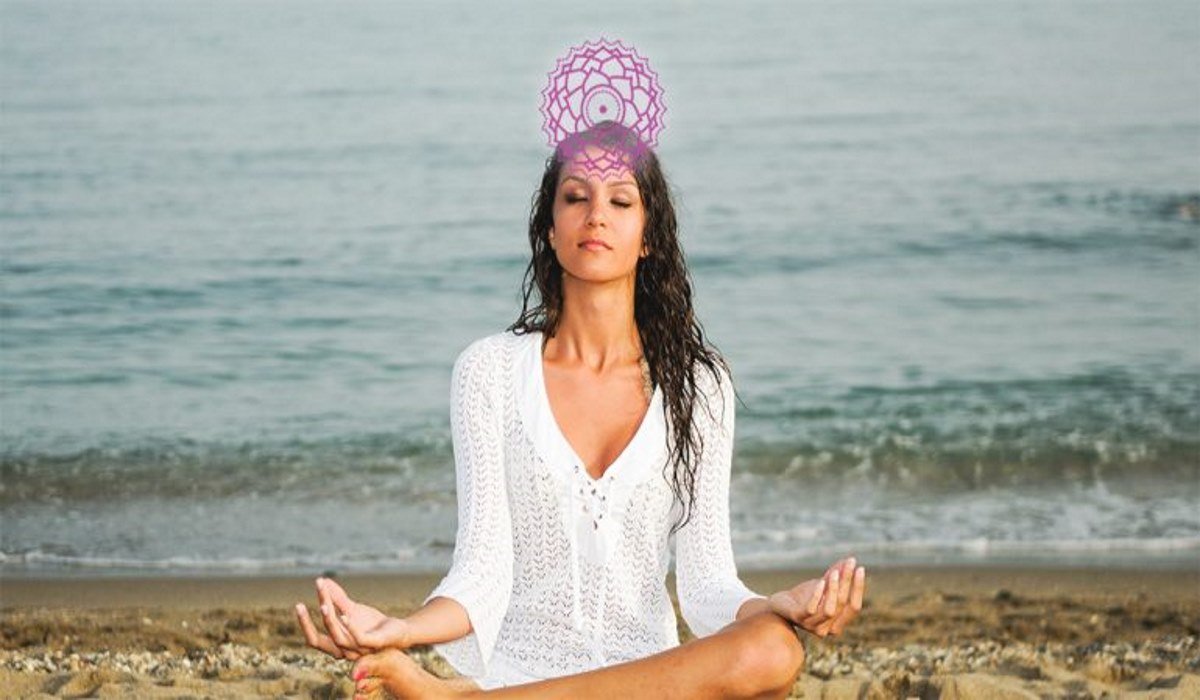Sahasrara is the seventh of our chakras, also known as the crown chakra as it is located at the extreme top of our head. Unlike the other six chakras, no organ governs, but being at the top of our energy centers, it is responsible for the proper functioning of the cerebral cortex and the pineal gland, as well as our highest forms of thought, such as transcendence, knowledge, and spirituality.
Its Sanskrit name literally means “a thousand times so much”, referring to the thousand petals of a lotus flower that slowly unfold, a metaphor for our personal and spiritual growth that reaches its peak at Sahasrara. The thousand is also a very significant number in the spiritual practices of oriental culture, cited in many ancient writings.
The Sahasrara chakra is in fact connected to our most pure and disinterested feelings, such as altruism, humility, trust, compassion, and forgiveness.
Sahasrara is depicted as a white and purple lotus with numerous filaments, with “a thousand petals” in which all fifty letters of the Sanskrit alphabet are inscribed, repeated 20 times. Inside it is inscribed a triangle and, in some representations, also the drawing of a full moon.
Table of Contents
The characteristics of the seventh chakra:
The element that represents this chakra is the metal and the colors associated with it are white, a symbol of enlightened thought and purity, and purple.
Thanks to the energy of the seventh chakra we are able to arrive at transcendental knowledge, which is the highest and purest form of knowing that exists: when Sahasrara is balanced, our capacity for understanding, consciousness and learning benefit. Thought evolves and becomes pure, uncontaminated, slowly turning us from observers to leaders and exercising a deep form of awareness once we transcend deleterious conceptions and let things happen through us.
Conversely, when the Sahasrara chakra is blocked, our lucid thinking suffers heavily. On the physical plane, we are subject to headaches, phobias, psychoses and in general all the types of discomfort that separate us from our personal growth path. The energy of the seventh chakra is very powerful, so its malfunction is always associated with very marked discomforts.
From a mental point of view, the closure of Sahasrara leads us to divert our attention to materialism rather than spirituality. We become perpetually dissatisfied and attach ourselves excessively to earthly goods, fleeing everything that transcends the physical plane. People with seventh chakra problems are often afraid of death and reject anything that does not have a rational explanation.
Recommended: The 7 Chakras: Characteristics and Special Exercises for Each One.
Exercise to rebalance the seventh chakra:
The best way to cure the seventh chakra is undoubtedly to practice transcendental meditation consistently. On the Hatha Yoga level, the following exercises can be performed one after the other:
1. To start, you will need to take the Mudra position. To do this, sit in a Vajrayana position (leaning your thighs on your heels) and then, inhaling, raise your arms above your head. Exhale, bend forward until the upper part of the body rests on the thighs and the head on the floor. Stay in this position for 2-3 minutes.

2. Now enter Bhumi Pada Mastakāsana: from the Vajrayana position, place your hands and head firmly on the floor in front of you. Stretch the toes, place them on the ground and straighten the legs so that the weight is distributed over the head, hands, and feet. Once you find your balance in this position then bring your arms and hands behind your back to complete the pose. Stay in this position for 2-3 minutes.
3. Now lean gently on your knees, raise your arms above your head and look towards your hands. Stay in this position for a couple of minutes.
4. Now it’s time to take a comfortable sitting position. Place your right hand on the Sahasrara chakra and your left hand on the Manipura chakra and sit in the full lotus position.
5. Repeat the mantra “Om” 27 times – before each Om visualize your energy passing between the two chakras as through a tube. A bright light radiates from the top of your head. With each inhalation, the tube expands and with each exhalation, your consciousness is elevated upward.
6. Now repeat the Om manta 27 more times, but this time close your ears with your thumbs. Then place your hands on your knees or thighs. Contemplate the inner sound that dissolves into a pure, bright white light that contains all the colors.
7. Concentrate on the seventh chakra, which shines like the rising sun. Feel the awareness of the inexhaustibility of your inner knowledge.
8. Complete the practice by repeating the mantra of peace 10 times, or “Om Shanti … Shanti … Shanti …”
Recommended: How to Balance Your Crown Chakra and Align with Your True Life Path.
Summary of the seventh Sahasrara chakra:
- Position: At the top of the head
- Function: Universal awareness or pure awareness
- Color: Purple and white
- Element: Metal
- Sense: Empathy
- Crystals and stones: Hyaline quartz, amethyst, diamond
- Mantra: Om
- Animal: None
Recommended Book for You:
Learn chakra balancing techniques so you’ll be able to heal your chakras into perfect alignment and attract wealth and abundance into your life.









